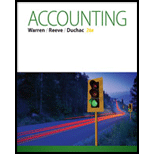
1. a)
Financial Ratios: Financial ratios are the metrics used to evaluate the liquidity, capabilities, profitability, and overall performance of a company.
Given info: Items of financial statement
The Rate earned on total assets for three years.
1. a)
Answer to Problem 17.4CP
Rate earned on total assets for three years:
Explanation of Solution
Rate earned on total assets determines the particular company’s overall earning power. It is determined by dividing sum of net income and interest expense and average total assets.
Formula:
Hence, rate earned on total assets for year 3, year 2, and year 1 are 7.4%, 7.8%, and 6.4% respectively.
b)
The Rate earned on
b)
Answer to Problem 17.4CP
Rate earned on stockholders’ equity for three years
Explanation of Solution
Rate earned on stockholders’ equity is used to determine the relationship between the net income and the average common equity that are invested in the company.
Formula:
Hence,
c)
The earnings per share on the common stock for three years.
c)
Answer to Problem 17.4CP
Earnings per share on the common stock for three years
Explanation of Solution
Earnings per share help to measure the profitability of a company. Earnings per share are the amount of profit that is allocated to each share of outstanding stock.
Formula
Hence, earnings per share for year 3, year 2, and year 1 is $7.72, $6.71, and $4.40.
d)
The dividend yield for three years.
d)
Answer to Problem 17.4CP
Dividend yield for three years
Explanation of Solution
Dividend yield ratio is determined to evaluate the relationship between the annual dividend per share and the market price per share.
Formula
Therefore, dividend yield ratio for Company year 3, year 2, and year 1 are 2.3%, 1.9%, and 1.9% respectively.
e)
The price earnings ratio for three years.
e)
Answer to Problem 17.4CP
Price earnings ratio for three years
Explanation of Solution
Dividend yield ratio is determined as the relationship between market price per share and earnings per share.
Formula
Therefore, price/earnings ratio for Company year 3, year 2, and year 1 are 10.3, 12.0, and 13.9.
2.
Ratio of average liabilities to average stockholders' equity for Year 3.
2.
Answer to Problem 17.4CP
Explanation of Solution
Ratio of average liabilities to average stockholders’ equity is determined by dividing average liabilities and average stockholders’ equity.
Formula:
Average liabilities for three years are determined as the difference between average assets and average stockholder’s equity. They are as below:
3.
To evaluate: D’s profitability.
3.
Explanation of Solution
D’s profitability is measured by earnings per share. It has been improved significantly during the 3-year period. The return on total assets and total stockholders’ equity has improved in a significant manner.
There is a significant improvement in the economy and thus, improved in the construction industry too for the year 2. The capital equipment has improved and thus, dividend yield has increased in the year 3. This increase is due to large increase in the cash dividend.
The price-earnings ratio has deteriorated during three-year period. The share price is increased in the slower rate when compared to earnings.
Want to see more full solutions like this?
Chapter 17 Solutions
ACCOUNTING,CHAP.1-13
- Summary: You will investigate a case of asset theft involving several fraudsters for this assignment. The case offers a chance to assess an organization's corporate governance, fraud prevention, and risk factors. Get ready: Moha Computer Services Limited Links to an external website: Finish the media activity. The scenario you need to finish the assignment is provided by this media activity. Directions: Make a four to five-page paper that covers the following topics. Management must be questioned by an auditor regarding the efficacy of internal controls and the potential for fraud. A number of warning signs point to the potential for fraud in this instance. List at least three red flags (risk factors for fraud) that apply to the Moha case. Sort them into three groups: opportunities, pressures/incentives, and (ethical) attitudes/justifications. Determine which people and organizations were impacted by Moha Computer Services Limited's enormous scam. Describe the fraud's financial and…arrow_forwardCoarrow_forwardCritically assess the role of the Conceptual Framework in financial reporting and its influence onaccounting theory and practice. Discuss how the qualitative characteristics outlined in theConceptual Framework enhance financial reporting and contribute to decision-usefulness. Provideexamples to support your analysis.arrow_forward
- Critically analyse the role of financial reporting in investment decision-making,emphasizing the qualitative characteristics that enhance the usefulness of financialstatements. Discuss how financial reporting influences both investor confidence andregulatory decisions, using relevant examples.arrow_forwardHelp need!!arrow_forwardAnswer please correarrow_forward
- Answer should be coarrow_forwardSolve quiarrow_forwardAssess the role of modern accounting theories in guiding research in accounting.Discuss how contemporary theories, such as stakeholder theory, legitimacy theory, andbehavioral accounting theory, shape research questions, hypotheses formulation, andempirical analysis.arrow_forward
 Managerial AccountingAccountingISBN:9781337912020Author:Carl Warren, Ph.d. Cma William B. TaylerPublisher:South-Western College Pub
Managerial AccountingAccountingISBN:9781337912020Author:Carl Warren, Ph.d. Cma William B. TaylerPublisher:South-Western College Pub Managerial Accounting: The Cornerstone of Busines...AccountingISBN:9781337115773Author:Maryanne M. Mowen, Don R. Hansen, Dan L. HeitgerPublisher:Cengage Learning
Managerial Accounting: The Cornerstone of Busines...AccountingISBN:9781337115773Author:Maryanne M. Mowen, Don R. Hansen, Dan L. HeitgerPublisher:Cengage Learning Financial AccountingAccountingISBN:9781337272124Author:Carl Warren, James M. Reeve, Jonathan DuchacPublisher:Cengage Learning
Financial AccountingAccountingISBN:9781337272124Author:Carl Warren, James M. Reeve, Jonathan DuchacPublisher:Cengage Learning Financial And Managerial AccountingAccountingISBN:9781337902663Author:WARREN, Carl S.Publisher:Cengage Learning,
Financial And Managerial AccountingAccountingISBN:9781337902663Author:WARREN, Carl S.Publisher:Cengage Learning, Financial AccountingAccountingISBN:9781305088436Author:Carl Warren, Jim Reeve, Jonathan DuchacPublisher:Cengage Learning
Financial AccountingAccountingISBN:9781305088436Author:Carl Warren, Jim Reeve, Jonathan DuchacPublisher:Cengage Learning





